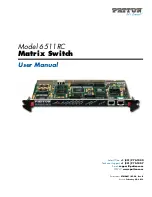
AAM1212 User’s Guide
Chapter 27 ADSL Commands
211
where
The
vcprofile set
command creates a virtual channel profile. After you create a virtual
channel profile, you can assign it to any of the ADSL ports on any of the ADSL AAMs in the
AAM.
The following example creates a virtual channel profile named gold that uses LLC
encapsulation. It uses constant bit rate and has the maximum rate (peak cell rate) set to
300,000 cells per second. The acceptable tolerance of the difference between a cell’s transfer
delay and the expected transfer delay (CDVT) is set to 5 cells.
ras> adsl vcprofile set gold llc cbr 300000 5
The following example creates a virtual channel profile named silver that uses VC
encapsulation. It uses real-time variable bit rate and has the maximum rate (peak cell rate) set
to 250,000 cells per second. The acceptable tolerance of the difference between a cell’s
transfer delay and the expected transfer delay (CDVT) is set to 5 cells. The average cell rate
that can be transmitted (SCR) is set to 100,000 cells per second. The maximum number of
cells that the port is guaranteed to handle without any discards (BT) is set to 200.
ras> adsl vcprofile set silver vc vbr 250000 5 100000 200
The following example creates a virtual channel profile named economy that uses LLC
encapsulation. It uses unspecified bit rate and has the maximum rate (peak cell rate) set to
50,000 cells per second. The acceptable tolerance of the difference between a cell’s transfer
delay and the expected transfer delay (CDVT) is set to 100 cells.
<vcprofile>
=
The name of the virtual channel profile (up to 31 ASCII
characters). You cannot change the
DEFVAL
or
DEFVAL_VC
profiles.
<vc|llc>
=
The type of encapsulation (vc or llc).
<ubr|cbr>
=
The ubr (unspecified bit rate) or cbr (constant bit rate) ATM
traffic class.
<pcr>
=
Peak Cell Rate (0 to 300000 or *), the maximum rate (cells per
second) at which the sender can send cells.
[cdvt]
=
Cell Delay Variation Tolerance is the accepted tolerance of the
difference between a cell’s transfer delay and the expected
transfer delay (number of cells). 0 to 255 cells or * (means 0).
<vbr(rt-
vbr)|nrt-vbr>
=
The real-time (vbr) or non real-time (nrt-vbr) Variable Bit Rate
ATM traffic class.
<scr>
=
The Sustained Cell Rate sets the average cell rate (long-term)
that can be transmitted (cells per second). SCR applies with the
vbr traffic class.
<bt>
=
Burst Tolerance this is the maximum number of cells that the
port is guaranteed to handle without any discards (number of
cells). BT applies with the vbr traffic class.
Summary of Contents for AAM1212
Page 1: ...AAM1212 ADSL2 Module over POTS in the IP DSLAM User s Guide Version 3 50 9 2005 ...
Page 23: ...AAM1212 User s Guide 22 ...
Page 27: ...AAM1212 User s Guide 26 ...
Page 35: ...AAM1212 User s Guide 34 Chapter 1 Getting to Know Your AAM1212 ...
Page 49: ...AAM1212 User s Guide 48 Chapter 3 Hardware Connections ...
Page 55: ...AAM1212 User s Guide 54 Chapter 4 Web Configurator Introduction ...
Page 63: ...AAM1212 User s Guide 62 Chapter 5 Initial Configuration ...
Page 71: ...AAM1212 User s Guide 70 Chapter 6 Home and Port Statistics Screens ...
Page 83: ...AAM1212 User s Guide 82 Chapter 7 Basic Setting Screens ...
Page 111: ...AAM1212 User s Guide 110 Chapter 8 ADSL Port Setup ...
Page 143: ...AAM1212 User s Guide 142 Chapter 18 Syslog ...
Page 151: ...AAM1212 User s Guide 150 Chapter 19 Access Control ...
Page 163: ...AAM1212 User s Guide 162 Chapter 22 Diagnostic ...
Page 181: ...AAM1212 User s Guide 180 Chapter 25 Commands Overview ...
Page 249: ...AAM1212 User s Guide 248 Chapter 29 IP Commands ...
Page 261: ...AAM1212 User s Guide 260 Chapter 30 Statistics Commands ...
Page 277: ...AAM1212 User s Guide 276 Chapter 33 Troubleshooting ...
Page 283: ...AAM1212 User s Guide 282 Virtual Circuit Topology ...
















































